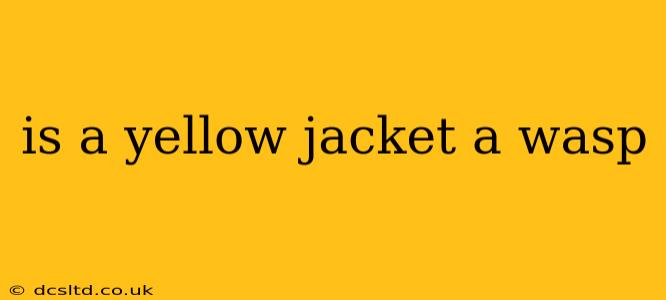Yes, a yellow jacket is a type of wasp. More specifically, yellow jackets belong to the Vespula genus within the family Vespidae, which encompasses a vast array of wasps. While all yellow jackets are wasps, not all wasps are yellow jackets. This distinction is crucial for understanding their behavior, habitat, and potential dangers.
What are the key differences between yellow jackets and other wasps?
Yellow jackets are easily recognizable by their distinctive black and yellow striped bodies. However, many other wasp species also exhibit similar coloring. What truly sets yellow jackets apart lies in their social structure, nesting habits, and aggressive behavior.
-
Social Structure: Yellow jackets are highly social insects, living in colonies with a queen, worker bees, and drones. Other wasps can be solitary, meaning they live alone, or they may form smaller, less organized social groups.
-
Nesting Habits: Yellow jackets are known for building their nests underground, often in burrows abandoned by rodents, or in wall voids and other concealed locations. Other wasps can build nests in trees, shrubs, or even on structures above ground. The nest structure itself can also differ significantly between yellow jackets and other wasp species.
-
Aggression: Yellow jackets are infamous for their aggressive nature, readily stinging humans and other animals when they feel threatened, even without provocation. Their stings are painful and can cause allergic reactions in some individuals. While many other wasp species can sting, their aggression level often differs; some are more docile and will only sting if directly threatened.
What are some common misconceptions about yellow jackets?
Many people confuse yellow jackets with other stinging insects like bees or hornets. It's important to distinguish them:
-
Bees vs. Yellow Jackets: Bees are typically fuzzier and have a more rounded body shape compared to the sleek, slender body of a yellow jacket. Bees are also crucial pollinators, while yellow jackets are more scavengers, feeding on nectar, insects, and even human food.
-
Hornets vs. Yellow Jackets: While both are wasps, hornets are generally larger than yellow jackets and often have different color patterns. Hornets also build larger, more noticeable nests, often exposed in trees or shrubs, unlike the hidden nests frequently found with yellow jackets.
Are yellow jacket stings dangerous?
Yes, yellow jacket stings can be dangerous, particularly for individuals allergic to their venom. A single sting can cause pain, swelling, and redness. Multiple stings can lead to more serious systemic reactions such as nausea, dizziness, and difficulty breathing. In severe cases, anaphylaxis, a life-threatening allergic reaction, can occur. If you experience any severe symptoms after being stung, seek immediate medical attention.
How can I prevent yellow jacket stings?
Avoiding encounters is the best way to prevent yellow jacket stings. This involves:
- Being cautious near potential nesting sites: Avoid disturbing areas where yellow jackets might nest, such as grassy areas, compost piles, and areas with decaying organic matter.
- Avoiding sweet smells and uncovered food: Yellow jackets are attracted to sweet drinks and foods. Keep food covered and spills cleaned up promptly.
- Wearing light-colored clothing: Dark colors can attract these insects.
- Staying calm if a yellow jacket approaches: Avoid swatting or making sudden movements, which can provoke them.
Understanding the distinctions between yellow jackets and other wasps can help you better appreciate their ecological role while also taking necessary precautions to prevent painful stings. Remember, while yellow jackets are indeed wasps, their aggressive nature and nesting habits warrant extra caution.
